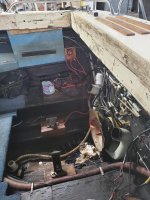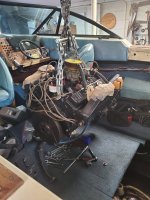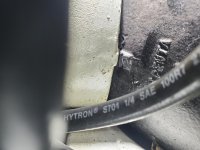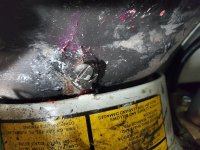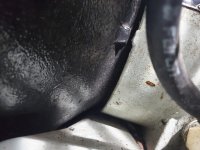1981Century
Member
Welp, I screwed up.
Bellows were replaced last year. U joints done by previous owner maybe 2 years ago. I ran the engine with the outdrive too high. There's a two inch gash in the u joint bellows at the 12 o clock position. I'm guessing from contact with the spinning assembly.
I was on the water today getting everything tuned up and I could hear an odd whirring sound, like water inside of a tube. I had very small amounts of water coming through the flywheel cover as well into the bilge.
Took the boat back home and pushed the upper bellows back, sure enough there's water. UJoints have a lot of surface rust.
I'm guessing I've compromised the PDS bearings, I know I have a 2 PDS style where the engine will probably have to be moved. No PDS replacement history that I'm aware of.
I have two options. Grease the PDS bearings and pray, or replace em.
I would guess the UJoints need to be replaced as well.
Ricardo, I have a few of your PDS write ups book marked, but I might have some other questions.
A couple questions, can I pull the PDS aft just enough to uncouple it from the engine and spin to check for bearing noise and end play? If not, then full replacement I'm assuming.
UJoints replacement...just remove the 4 top bolts and pull the top of the drive, UJoints and all or pull the entire drive?
I'll send some pics of the engine compartment, my hope is I can just lift the engine up enough to clear the mounting studs and pull it forward, but I'm not sure how much space I'll need to access the forward seal, clip and bearing.
Bellows were replaced last year. U joints done by previous owner maybe 2 years ago. I ran the engine with the outdrive too high. There's a two inch gash in the u joint bellows at the 12 o clock position. I'm guessing from contact with the spinning assembly.
I was on the water today getting everything tuned up and I could hear an odd whirring sound, like water inside of a tube. I had very small amounts of water coming through the flywheel cover as well into the bilge.
Took the boat back home and pushed the upper bellows back, sure enough there's water. UJoints have a lot of surface rust.
I'm guessing I've compromised the PDS bearings, I know I have a 2 PDS style where the engine will probably have to be moved. No PDS replacement history that I'm aware of.
I have two options. Grease the PDS bearings and pray, or replace em.
I would guess the UJoints need to be replaced as well.
Ricardo, I have a few of your PDS write ups book marked, but I might have some other questions.
A couple questions, can I pull the PDS aft just enough to uncouple it from the engine and spin to check for bearing noise and end play? If not, then full replacement I'm assuming.
UJoints replacement...just remove the 4 top bolts and pull the top of the drive, UJoints and all or pull the entire drive?
I'll send some pics of the engine compartment, my hope is I can just lift the engine up enough to clear the mounting studs and pull it forward, but I'm not sure how much space I'll need to access the forward seal, clip and bearing.


